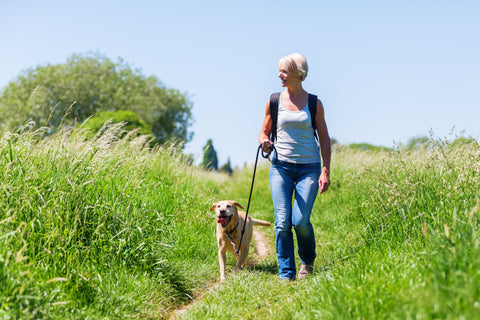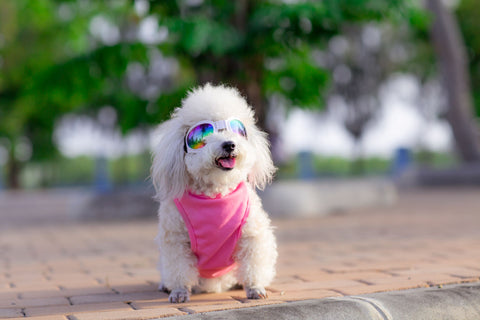

Key Highlights
- Exercising with your dog is great way to bond improve the health of both you and your furry friend.
- Walking and jogging are excellent low-impact exercises that can be enjoyed by dogs of all fitness levels.
- Canine freestyle dancing and agility training courses provide mental stimulation and physical exercise for your dog.
- Swimming is a fantastic workout for water-loving dogs, especially seniors or dogs with joint problems.
- Organizing doggy playdates and going on scenic hikes are great ways to socialize and exercise with your dog.
- Biking with a dog jogger and practicing doga sessions offer unique and enjoyable exercise options for dogs and their owners.
What are the benefits of regular exercise for dogs?
Regular exercise for dogs helps maintain a healthy weight, strengthens muscles, improves cardiovascular health, enhances joint flexibility, and boosts mental stimulation. It also reduces behavior problems by combating boredom and provides an opportunity for socialization with other dogs and humans.
Introduction
Exercising is not only important for humans but also for our furry friends. Regular exercise helps dogs maintain a healthy weight, improve their overall health, and prevent behavioral issues. Plus, it's a great way to bond with your four-legged companion and have fun together. In this blog, we will explore ten engaging exercise activities for dogs and their owners.
Keeping our dogs mentally stimulated and physically active is crucial for their well-being. From discovering the joy of canine freestyle dancing to stimulating agility training courses, there are plenty of options to choose from. We will also discuss the benefits of regular exercise for dogs and how to choose the right exercise based on your dog's breed. Additionally, we will provide some safety tips for exercising with your dog.
So, grab your dog's leash and get ready to embark on a healthy and exciting exercise routine that will not only benefit your dog but also strengthen the bond between you and your furry friend.
10 Engaging Exercise Activities for Dogs and Their Owners
Regular exercise is essential for dogs to stay happy and healthy. Here are ten engaging exercise activities that you and your dog can enjoy together:
1. Discover the Joy of Canine Freestyle Dancing
Canine freestyle dancing is a unique and fun activity that combines obedience training and dancing. It involves performing a routine to music with your dog, incorporating various tricks, jumps, and spins. Not only does it provide physical exercise for your dog, but it also offers mental stimulation and strengthens the bond between you and your furry friend. Any dog breed can participate in canine freestyle dancing, and you can tailor the routine to your dog's abilities and preferences.
2. Interactive Fetch Games in the Park
Playing fetch is a classic and enjoyable game for dogs of all ages and sizes. Take your furry friend to the park or an open space, and throw a ball or a Frisbee for them to chase and retrieve. This game provides excellent cardiovascular exercise and helps your dog release pent-up energy. It's also a great way to strengthen the bond between you and your dog while enjoying the outdoors. Remember to choose appropriate toys for your dog's size and breed, and always supervise the game to ensure their safety.
3. Adventure-Filled Trail Running
If you and your dog are up for a more intense workout, trail running is a fantastic option. Lace up your running shoes, attach your dog's leash securely, and hit the trails together. Trail running not only provides regular exercise for both you and your dog but also offers a change of scenery and a chance to explore nature. It improves cardiovascular health, increases endurance, and helps maintain healthy energy levels. However, make sure to choose trails that are suitable for running and check with your veterinarian if your dog is in good health for this activity, especially if they have any heart disease or other medical conditions.
4. Stimulating Agility Training Courses
Agility training courses are a great way to challenge your dog's physical and mental abilities. These courses consist of various obstacles, such as jumps, tunnels, and weave poles, that your dog must navigate with your guidance. Agility training not only improves your dog's coordination and physical fitness but also enhances their problem-solving skills. It is a popular dog sport that offers a structured and engaging exercise routine. You can enroll your dog in agility classes or set up an obstacle course in your backyard. Remember to start with simple obstacles and gradually increase the difficulty level as your dog becomes more confident and skilled.
5. Fun-Filled Beach Day and Swimming
If you and your dog love the water, a fun-filled beach day is the perfect exercise activity. Swimming is an excellent low-impact workout that provides a full-body exercise for your dog. It is especially beneficial for larger breeds and dogs with joint problems, as it takes the weight off their joints while still providing a good workout. Whether it's splashing in the waves or retrieving a toy from the water, swimming offers a refreshing and enjoyable way to exercise with your furry friend. Just make sure to choose dog-friendly beaches and keep an eye on your dog's safety, especially in open water.
6. Engaging in Tug-of-War Challenges
Tug-of-war is a classic game that offers mental stimulation and strength training for your dog. It's a great way to engage their mind and satisfy their natural instincts. Grab a sturdy rope or a tug toy and let your dog pull and tug while you hold on to the other end. This game not only provides physical exercise but also strengthens your dog's jaw muscles and promotes good dental health. It's important to teach your dog proper tug toy etiquette, such as releasing the toy when asked, to ensure a safe and enjoyable game for both of you.
7. Organizing a Doggy Playdate
Socialization is crucial for dogs to develop good behavior and positive interactions with other animals and people. Organizing a doggy playdate is a fun and interactive way for your dog to socialize with other dogs while getting exercise. You can invite friends or neighbors who have dogs to join you in a local park or a safe, enclosed area. Let the dogs interact and play while you and the other pet owners supervise. This activity not only provides physical exercise but also helps dogs learn important social skills and build confidence. You can also join community runs or doggy playgroups to meet other dog owners and enjoy group activities with your furry friend.
8. Trekking Together on Scenic Hikes
Hiking is a wonderful activity that allows you to spend quality time with your dog while enjoying the beauty of nature. It's a perfect opportunity to explore new trails, breathe in fresh air, and enhance your overall health. Trekking on scenic hikes provides both physical exercise and mental stimulation for your dog, as they encounter new smells and sights. Make sure to choose hiking trails that are suitable for dogs and follow local regulations regarding leashes and waste disposal. Bring plenty of water and snacks for both you and your dog, and enjoy the adventure together.
9. Explorative Biking with a Dog Jogger
If you enjoy biking, why not include your dog in your exercise routine? Biking with a dog jogger is a fantastic way to combine your fitness goals with your dog's exercise needs. A dog jogger is specifically designed to attach to your bike and provide a safe and comfortable space for your dog to ride along. This activity allows you to cover more distance and explore different areas while giving your dog a chance to enjoy the outdoors. Before biking with your dog, make sure they are comfortable with the dog jogger and that it is securely attached to your bike. Start with short rides to familiarize your dog with the experience and gradually increase the duration and intensity as they get used to it. Choose bike-friendly paths or trails, and always prioritize your dog's safety and well-being.
10. Practicing Mindful Doga Sessions
Doga, or dog yoga, is a unique and calming exercise activity that combines traditional yoga poses with your dog's presence. Practicing doga sessions creates a peaceful and mindful atmosphere, benefiting both you and your dog. It provides an opportunity to bond and relax together while stretching and strengthening your bodies. Doga can be especially beneficial for senior dogs or dogs with joint problems, as it offers gentle stretches and promotes flexibility. You can incorporate your dog into various yoga poses, such as downward dog and upward-facing dog, and enjoy the soothing effects of petting and stroking them during the practice. Make sure to choose a quiet and comfortable space, use yoga mats for both you and your dog, and follow proper alignment and safety guidelines.
Benefits of Regular Exercise for Dogs
Regular exercise is essential for dogs to maintain good health and well-being. Here are some of the key benefits of regular exercise for dogs:
Enhancing Physical Health and Reducing Obesity
Regular exercise improves dogs' physical health and boosts their endurance and stamina. It helps them maintain a healthy weight, reduces the risk of obesity-related health issues, and promotes cardiovascular fitness. Dogs who get regular exercise are less likely to develop heart disease, diabetes, and joint problems. Additionally, exercise strengthens their muscles and bones, improves their flexibility and coordination, and enhances overall physical performance. Whether it's through walking, running, swimming, or playing games, regular exercise keeps dogs active and energized.
Strengthening the Bond Between Dog and Owner
Regular exercise provides an excellent opportunity for dog owners to strengthen the bond with their furry companions. Spending quality time together during exercise creates a sense of trust and companionship. Dogs thrive on human interaction and enjoy the attention and positive reinforcement they receive during exercise sessions. The shared experiences and activities build a strong emotional connection between dog and owner, leading to a happier and more fulfilling relationship. Regular exercise also helps dogs develop a deeper understanding of their owners' cues and commands, enhancing their training and obedience.
Reducing Behavioral Issues Through Stimulation
Regular exercise plays a crucial role in reducing behavioral issues in dogs. Dogs who are physically and mentally stimulated are less likely to engage in destructive or problematic behaviors. Exercise provides an outlet for their natural instincts and energy, preventing boredom and frustration. Mental stimulation, such as training exercises and interactive games, helps keep their minds sharp and engaged. Regular exercise also promotes better sleep quality, which contributes to overall well-being and a calmer demeanor. By providing consistent exercise routines, dog owners can help their furry friends develop self-control, discipline, and obedience.
Choosing the Right Exercise Based on Your Dog's Breed
Different dog breeds have different exercise needs and preferences. It's important to consider your dog's breed-specific characteristics when choosing the right exercise activities. For example, high-energy working breeds may require more intense and challenging exercises, such as agility training or long-distance running. On the other hand, smaller breeds or dogs with certain health conditions, such as hip dysplasia, may benefit from low-impact activities like swimming or gentle walks. Understanding your dog's breed-specific needs will help ensure they get the right amount and type of exercise to keep them happy and healthy.
Understanding Breed-Specific Needs and Preferences
Different dog breeds have different energy levels, exercise requirements, and preferences. High-energy breeds, such as Border Collies or Australian Shepherds, thrive on intense activities that challenge their physical and mental abilities. They enjoy tasks like agility training or hiking long distances. Smaller breeds, like Chihuahuas or Shih Tzus, may prefer shorter walks or interactive indoor games that provide mental stimulation. Understanding your dog's breed-specific needs and preferences will help you choose the right exercise activities to keep them happy and healthy. Research your dog's breed characteristics and consult with your veterinarian to determine the best exercise routine for your furry friend.
Adapting Activities for Small, Medium, and Large Breeds
When choosing exercise activities for your dog, it's important to consider their size and physical capabilities. Small breeds, such as Dachshunds or Yorkshire Terriers, may have shorter legs and lower endurance levels, so shorter walks or interactive indoor games may be more suitable for them. Medium-sized breeds like Bulldogs or Beagles may require moderate-intensity exercises like jogging or playing fetch. Larger breeds, such as Labrador Retrievers or German Shepherds, may have higher energy levels and require more intense activities like swimming or trail running. Adapting activities based on your dog's size will help prevent overexertion or injury and ensure they get the right amount of exercise for their needs.
Exercising Puppies
Exercising puppies is a crucial aspect of their development. It's essential to remember that puppies have growing bodies and should not engage in high-impact activities that could harm their joints or bones. Instead, focus on providing them with short play sessions, gentle walks, and basic training exercises to help build their muscles and coordination. As they grow, gradually increase the intensity and duration of their exercise to match their energy levels and physical capabilities. Always monitor your puppy during exercise to ensure they are not overexerting themselves and consult with your veterinarian for guidance on creating a suitable exercise plan for your furry companion.
Safety Tips for Exercising With Your Dog
When exercising with your dog, it's important to prioritize their safety and well-being. Here are some safety tips to keep in mind:
Pre-Exercise Health Checks and Hydration
Before starting any new exercise routine, it's a good idea to consult with your veterinarian. They can assess your dog's overall health and make recommendations based on their specific needs and any pre-existing medical conditions. Additionally, ensure that your dog is well-hydrated before, during, and after exercise. Carry water and a portable bowl for your dog, especially on hot days or during intense workouts. Regularly check for signs of dehydration, such as excessive panting, dry gums, or lethargy, and take breaks as needed to allow your dog to rest and drink water.
Monitoring Signs of Overexertion and Heatstroke
Exercise should be enjoyable and safe for your dog. It's important to monitor for signs of overexertion and heatstroke, especially during hot and humid weather. Be aware of symptoms like excessive panting, difficulty breathing, drooling, weakness, and disorientation. If you notice any of these signs, immediately stop the exercise, find shade or a cool area, and provide water to your dog. Wetting their paws and abdomen with water can also help to cool them down. If your dog's symptoms worsen or if they show signs of heatstroke, such as vomiting or collapse, seek veterinary attention immediately. Heatstroke can be life-threatening and requires prompt medical intervention.
Conclusion
Keeping your furry friend active and healthy is a priority for every pet parent. Engaging in fun exercise activities not only boosts their physical well-being but also strengthens the bond between you and your dog. From freestyle dancing to beach days and agility training, there are numerous ways to keep them entertained and fit. Remember to tailor the exercises to suit your dog's breed and always prioritize safety with pre-exercise checks and hydration. Regular exercise is key to a happy and fulfilled canine companion, so grab a toy, hit the trails, and enjoy the benefits of an active lifestyle together!
Frequently Asked Questions
How Often Should I Exercise My Dog?
The amount of exercise your dog needs depends on their age, breed, and overall health. Generally, dogs should have at least 30 minutes to 2 hours of exercise per day. Active dogs may require more frequent and intense exercise, while senior dogs and puppies may need shorter and gentler exercise sessions. Consult with your veterinarian to determine the appropriate exercise routine for your dog's specific needs.
What Are Some Indoor Exercise Options for Dogs?
There are plenty of indoor exercise options for dogs, especially during inclement weather or for those living in apartments. Some indoor activities include playing interactive games like hide-and-seek or treasure hunts, practicing obedience training, or using puzzle toys that provide mental stimulation. You can also engage your dog in indoor exercises like a game of fetch in a spacious room or using a soft toy.
Can Older Dogs Participate in These Exercise Activities?
Yes, older dogs can participate in exercise activities, but it's important to consider their age and any pre-existing health conditions. Senior dogs may require shorter and more gentle exercise sessions, allowing them to go at their own pace. Low-impact activities like swimming or gentle walks can be beneficial for older dogs with joint problems. Consult with your veterinarian to determine the most suitable exercise routine for your senior dog.
Are There Any Specific Precautions for Exercise in Extreme Weather?
In extreme weather conditions, such as extreme heat or cold, it's important to take extra precautions when exercising with your dog. Avoid exercising during the hottest times of the day and provide plenty of water for hydration. In cold weather, protect your dog from freezing temperatures and check for signs of frostbite or hypothermia. Always prioritize your dog's safety and well-being in extreme weather conditions.






